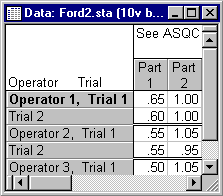Repeatability & Reproducibility Analysis - Analyze R & R Data Sheet Tab
Select the Analyze R & R data sheet tab of the Repeatability & Reproducibility Analysis dialog box to access options to specify the data that are to be analyzed for the repeatability and reproducibility experiment. It is assumed that the data were entered into a Statistica file in the form of a standard R & R data sheet.
That is, that the data for each part were entered into separate columns, and that successive rows of data represent the results for different trials for each operator or appraiser (i.e., trials within operators). Thus, it is expected that there are as many rows in the data file as there are trials times operators.
Note: Statistica expects as many variables as there are parts (the data for each part entered into separate columns in the data spreadsheet), and as many valid cases as there are operators times trials (the consecutive rows of data represent the consecutive trials across the operators, i.e., trials within operators).
Number of operators
Specify the number of different operators in the design. These are the different individuals who are taking the measurements. Comparing operators will later allow you to determine the reproducibility of the measurements. For further details, refer also to the description of this method in the Introductory Overview.
Number of parts
Specify the number of different parts that are measured in the study.
Number of trials
Specify the number of different trials in the design. In order to estimate the repeatability of the measurements, you need to include at least 2 trials; that is, allow each operator to measure each part at least twice. However, you can specify only a single-trial experiment; in that case, repeatability and reproducibility cannot be estimated separately. These types of "abridged" studies are often useful in order to perform periodic checks on the precision of the measurement system.
Variables
Click the Variables button to display the standard variable selection dialog. Specify as many variables as you specified parts for the R & R experiment.
